Demography of London
The demography of London is analysed by the Office for National Statistics and data is produced for each of the Greater London wards, the City of London and the 32 London boroughs, the Inner London and Outer London statistical sub-regions, each of the Parliamentary constituencies in London, and for all of Greater London as a whole. Additionally, data is produced for the Greater London Urban Area. Statistical information is produced about the size and geographical breakdown of the population, the number of people entering and leaving country and the number of people in each demographic subgroup. The total population of London as of 2021 is 8,799,800.[6]
| Demographics of London | |
|---|---|
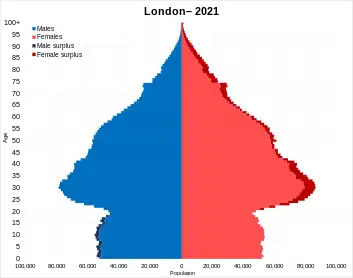 | |
| Population | |
| Density | |
| Growth rate | |
| Life expectancy | |
| • male | |
| • female | |
| Fertility rate | |
| Infant mortality rate | |
| Nationality | |
| Nationality | British |
| Major ethnic |
|
| Minor ethnic |
|
| Language | |
| Spoken | British English (main language: 78.4%) |
History
Creation of Greater London - 1965
Through the London Government Act of 1963, the Greater London region was established officially in 1965.[7]
Migration boom - 1997 to today
From 1997 onwards, London has experienced a drastic change in the composition of the city's population, which has off set the decline of the population which had been occurring. In 1991, 21.7% of the city was foreign born but by 2011 this had risen to 36.7%.
In 2011, a historic tipping point occurred with the release of the 2011 census indicating that the White British population, which had before been the majority, was now no longer a majority of the city's population, although it remained by far the largest single ethnic group.[8]
Population

| Year | Pop. | ±% p.a. |
|---|---|---|
| 1801 | 1,011,157 | — |
| 1811 | 1,197,673 | +1.71% |
| 1821 | 1,450,122 | +1.93% |
| 1831 | 1,729,949 | +1.78% |
| 1841 | 1,917,013 | +1.03% |
| 1851 | 2,286,609 | +1.78% |
| 1861 | 3,094,391 | +3.07% |
| 1871 | 3,902,178 | +2.35% |
| 1881 | 4,709,960 | +1.90% |
| 1891 | 5,565,856 | +1.68% |
| 1901 | 6,226,494 | +1.13% |
| 1911 | 7,157,875 | +1.40% |
| 1921 | 7,553,526 | +0.54% |
| 1931 | 8,098,942 | +0.70% |
| 1941 | 7,987,936 | −0.14% |
| 1951 | 8,164,416 | +0.22% |
| 1961 | 7,781,342 | −0.48% |
| 1971 | 7,449,184 | −0.44% |
| 1981 | 6,608,513 | −1.19% |
| 1991 | 6,887,280 | +0.41% |
| 2001 | 7,172,036 | +0.41% |
| 2011 | 8,173,941 | +1.32% |
| 2019[9] | 8,961,989 | +1.16% |
| 2021 | 8,799,800 | −0.91% |
The historical population for the current area of Greater London, divided into the statistical areas of Inner and Outer London is as follows:
| London population over time[10][11][12] | |||
|---|---|---|---|
| Year | Inner London | Outer London | Greater London |
| 1801 | 879,491 | 131,666 | 1,011,157 |
| 1811 | |||
| 1821 | |||
| 1831 | |||
| 1841 | |||
| 1851 | |||
| 1861 | |||
| 1871 | |||
| 1881 | |||
| 1891 | |||
| 1901 | |||
| 1911 | |||
| 1921 | |||
| 1931 | |||
| 1941 | |||
| 1951 | |||
| 1961 | |||
| 1971 | |||
| 1981 | |||
| 1991 | |||
| 2001 | |||
| 2011[13] | |||
| 2021 | |||
Age

- Population pyramid of each borough in London
 Barking and Dagenham
Barking and Dagenham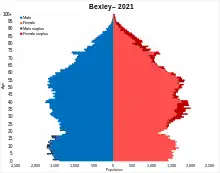 Bexley
Bexley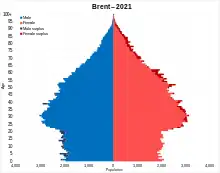 Brent
Brent Bromley
Bromley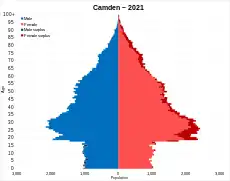 Camden
Camden City of London
City of London Croydon
Croydon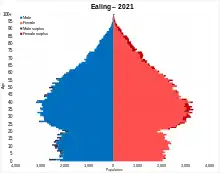 Ealing
Ealing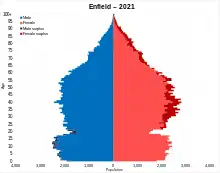 Enfield
Enfield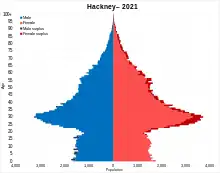 Hackney
Hackney Greenwich
Greenwich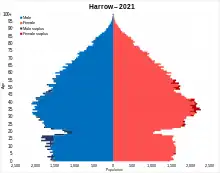 Harrow
Harrow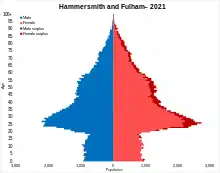 Hammersmith and Fulham
Hammersmith and Fulham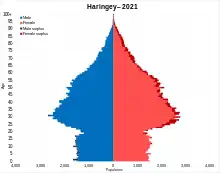 Haringey
Haringey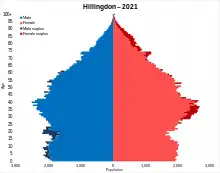 Hillingdon
Hillingdon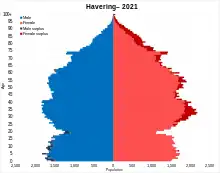 Havering
Havering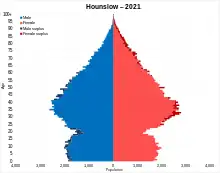 Hounslow
Hounslow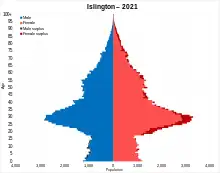 Islington
Islington Kensington and Chelsea
Kensington and Chelsea Kingston upon Thames
Kingston upon Thames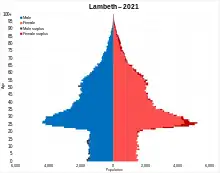 Lambeth
Lambeth Lewisham
Lewisham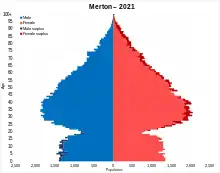 Merton
Merton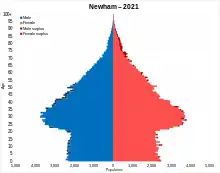 Newham
Newham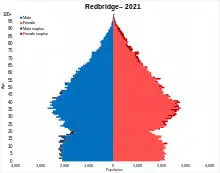 Redbridge
Redbridge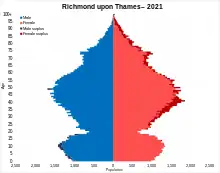 Richmond upon Thames
Richmond upon Thames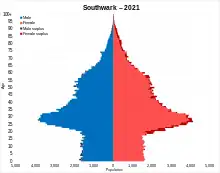 Southwark
Southwark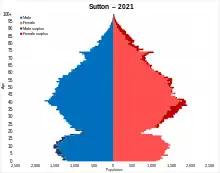 Sutton
Sutton Waltham Forest
Waltham Forest Tower Hamlets
Tower Hamlets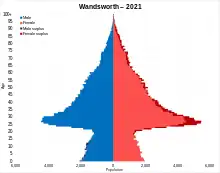 Wandsworth
Wandsworth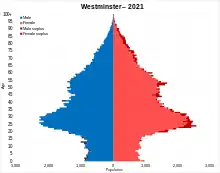 Westminster
Westminster
- Percentage of the population in age groups
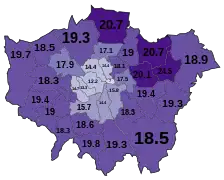 Under 15s in London
Under 15s in London_in_London.svg.png.webp) 15 to 64 year olds
15 to 64 year olds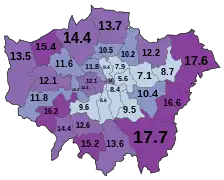 Over 64 years old
Over 64 years old
Fertility

In 2021, a total of 110,961 live births occurred within the city.[14] The fertility rate of London in 2021 was 1.52, which is below replacement.[4]
- Birth statistics in London
 Teenage conception rate in London
Teenage conception rate in London
Population density

The population density of London was 5,727 per km2 in 2011.[15]
Urban and metropolitan area
At the 2001 census, the population of the Greater London Urban Area was 8,278,251.[16] This area does not include some outliers within Greater London, but does extend into the adjacent South East England and East of England regions. In 2004 the London Plan of the Mayor of London defined a metropolitan region with a population of 18 million.[17] Eurostat has developed a harmonising standard for comparing metropolitan areas in the European Union and the population of the London Larger Urban Zone is 11,917,000; it occupies an area of 8,920 square kilometres (3,440 sq mi). Another definition gives the population of the metropolitan area as 13,709,000.[18]
Ethnicity
For the overwhelming majority of London's history, the population of the city was ethnically homogenous with the population being of White British ethnic origin,[19] with small clusters of minority groups such as Jewish people, most notably in areas of the East End. From 1948 onwards and especially since the Blair government in the late 1990s and 2000s, the population has diversified in international terms at an increased rate.[19] In 2011, it was reported for the first time that White British people had become a minority within the city, establishing it was a majority-minority city within the country.[8] In 2005, a survey of London's ethnic and religious diversity claimed that there were more than 300 languages spoken and 50 non-indigenous communities with a population of more than 10,000 in London.[20]
Ethnicity overall



The following table shows the ethnic group of respondents from estimates in 1971 and in the 1991 – 2021 censuses in Greater London.
| Ethnic Group | Year | |||||||||||||
|---|---|---|---|---|---|---|---|---|---|---|---|---|---|---|
| 1961 estimations[21][22] | 1971 estimations[19][23] | 1981 estimations[24][25] | 1991[26] | 2001[27] | 2011[28] | 2021[29] | ||||||||
| Number | % | Number | % | Number | % | Number | % | Number | % | Number | % | Number | % | |
| White: Total | 7,602,233 | 97.7% | 6,901,596 | 92.6% | 5,663,496 | 85.7% | 5,333,580 | 79.80% | 5,103,203 | 71.15% | 4,887,435 | 59.79% | 4,731,172 | 53.8% |
| White: British[Note 1] | – | – | 6,500,000 | 87% | – | – | – | – | 4,287,861 | 59.79% | 3,669,284 | 44.89% | 3,239,281 | 36.8% |
| White: Irish | – | – | 401,596 | 5.4% | – | – | 256,470 | 3.83% | 220,488 | 3.07% | 175,974 | 2.15% | 156, 333 | 1.8% |
| White: Gypsy or Irish Traveller[Note 2] | – | – | – | – | – | – | – | – | 8,196 | 0.10% | 7031 | 0.1% | ||
| White: Roma | – | – | – | – | – | – | – | – | – | – | 37,689 | 0.4% | ||
| White: Other[Note 1] | – | – | – | – | – | – | 594,854 | 8.29% | 1,033,981 | 12.65% | 1,290,838 | 14.7% | ||
| Asian or Asian British: Total | – | – | – | – | – | – | 690,031 | 10.33% | 946,894 | 13.20% | 1,511,546 | 18.49% | 1,817,640 | 20.8% |
| Asian or Asian British: Indian | – | – | – | – | – | – | 347,091 | 5.19% | 436,993 | 6.09% | 542,857 | 6.64% | 656,272 | 7.5% |
| Asian or Asian British: Pakistani | – | – | – | – | – | – | 87,816 | 1.31% | 142,749 | 1.99% | 223,797 | 2.74% | 290,549 | 3.3% |
| Asian or Asian British: Bangladeshi | – | – | – | – | – | – | 85,738 | 1.28% | 153,893 | 2.15% | 222,127 | 2.72% | 322,054 | 3.7% |
| Asian or Asian British: Chinese[Note 3] | – | – | – | – | – | – | 56,579 | 0.84% | 80,201 | 1.12% | 124,250 | 1.52% | 147,520 | 1.7% |
| Asian or Asian British: Other Asian | – | – | – | – | – | – | 112,807 | 1.68% | 133,058 | 1.86% | 398,515 | 4.88% | 401,245 | 4.6% |
| Black or Black British: Total | – | – | – | – | – | – | 535,216 | 8.01% | 782,849 | 10.92% | 1,088,640 | 13.32% | 1,188,370 | 13.5% |
| Black or Black British: African | – | – | – | – | – | – | 163,635 | 2.44% | 378,933 | 5.28% | 573,931 | 7.02% | 697,054 | 7.9% |
| Black or Black British: Caribbean | – | – | – | – | – | – | 290,968 | 4.35% | 343,567 | 4.79% | 344,597 | 4.22% | 345,405 | 3.9% |
| Black or Black British: Other Black | – | – | – | – | – | – | 80,613 | 1.20% | 60,349 | 0.84% | 170,112 | 2.08% | 145,911 | 1.7% |
| Mixed or British Mixed: Total[Note 1] | – | – | – | – | – | – | – | – | 226,111 | 3.15% | 405,279 | 4.96% | 505,775 | 5.7% |
| Mixed: White and Black Caribbean | – | – | – | – | – | – | – | – | 70,928 | 0.99% | 119,425 | 1.46% | 132,555 | 1.5% |
| Mixed: White and Black African | – | – | – | – | – | – | – | – | 34,182 | 0.48% | 65,479 | 0.80% | 77,341 | 0.9% |
| Mixed: White and Asian | – | – | – | – | – | – | – | – | 59,944 | 0.84% | 101,500 | 1.24% | 125,188 | 1.4% |
| Mixed: Other Mixed | – | – | – | – | – | – | – | – | 61,057 | 0.85% | 118,875 | 1.45% | 170,691 | 1.9% |
| Other: Total | – | – | – | – | – | – | 120,872 | 1.81% | 113,034 | 1.58% | 281,041 | 3.44% | 556,768 | 6.3% |
| Other: Arab[Note 2] | – | – | – | – | – | – | – | – | – | – | 106,020 | 1.30% | 139,791 | 1.6% |
| Other: Any other ethnic group | – | – | – | – | – | – | – | – | 113,034 | 1.58% | 175,021 | 2.14% | 416,977 | 4.7% |
| Non-White: Total | 179,109 | 2.3% | 547,588 | 7.4% | 945,017 | 14.3% | 1,346,119 | 20.2% | 2,068,888 | 28.85% | 3,286,506 | 40.2% | 4,068,553 | 46.2% |
| Total | 7,781,342 | 100% | 7,449,184 | 100% | 6,608,513 | 100% | 6,679,699 | 100.00% | 7,172,091 | 100.00% | 8,173,941 | 100.00% | 8,799,725 | 100% |
- New category created for the 2001 census
- New category created for the 2011 census
- In 2001, listed under the 'Other ethnic group' heading.
 White (2021)
White (2021)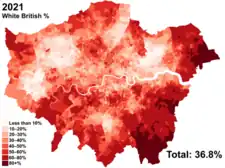 White-British (2021)
White-British (2021)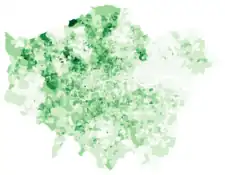 White-Irish (2021)
White-Irish (2021)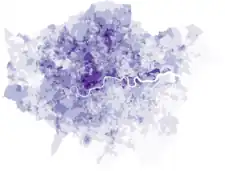 White-Other White (2021)
White-Other White (2021)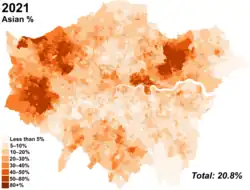 Asian (2021)
Asian (2021) Asian-Bangladeshi (2021)
Asian-Bangladeshi (2021)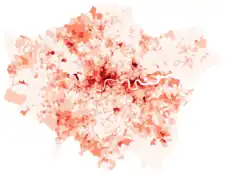 Asian-Chinese (2021)
Asian-Chinese (2021)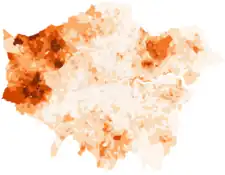 Asian-Indian (2021)
Asian-Indian (2021)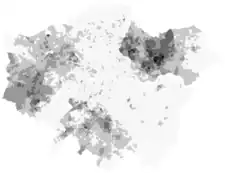 Asian-Pakistani (2021)
Asian-Pakistani (2021)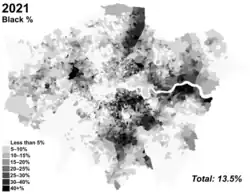 Black (2021)
Black (2021)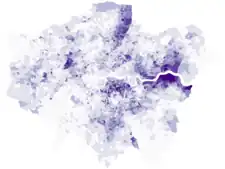 Black-African (2021)
Black-African (2021)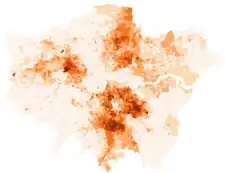 Black-Caribbean (2021)
Black-Caribbean (2021)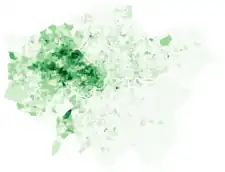 Other-Arab (2021)
Other-Arab (2021)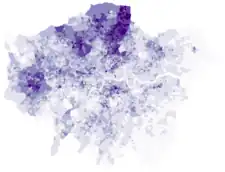 Other-Any Other Ethnic Group (2021)
Other-Any Other Ethnic Group (2021)

- Population pyramids of each ethnic group in London
 White: Total
White: Total White British
White British White Irish
White Irish White Other
White Other Asian: Total
Asian: Total Asian Bangladeshi
Asian Bangladeshi Asian Indian
Asian Indian Asian Pakistani
Asian Pakistani Asian Chinese
Asian Chinese Other Asian
Other Asian Black: Total
Black: Total Black: Caribbean
Black: Caribbean Black: African
Black: African Other Black
Other Black Mixed: Total
Mixed: Total Other: Total
Other: Total Other: Any other ethnic group
Other: Any other ethnic group Other: Arabs
Other: Arabs
Ethnicity of school pupils
| Ethnic group | School year[30][31] | |||||||||||||
|---|---|---|---|---|---|---|---|---|---|---|---|---|---|---|
| 2004 | 2008 | 2012 | 2015/16 | 2017/18 | 2019/20 | 2021/2022 | ||||||||
| Number | % | Number | % | Number | % | Number | % | Number | % | Number | % | Number | % | |
| White: Total | 467,230 | 51.4% | 431,040 | 46.7% | 416,490 | 42.8% | 443,621 | 41.1% | 522,187 | 40.4% | 520,767 | 39.8% | 506,271 | 38.7% |
| White: British | 389,350 | 42.9% | 339,610 | 36.8% | 305,805 | 31.4% | 295,572 | 27.4% | 333,497 | 25.8% | 324,358 | 24.8% | 312,522 | 23.9% |
| White: Irish | 10,610 | 1.2% | 8,610 | 0.9% | 7,610 | 0.8% | 6,939 | 0.6% | 7,322 | 0.6% | 6,759 | 0.5% | 6,268 | 0.5% |
| White: Traveller of Irish heritage | 1,090 | 0.1% | 920 | 0.1! | 1,000 | 0.1% | 1,031 | 0.1% | 1,183 | 0.1% | 1,205 | 0.1% | 1,182 | 0.9% |
| White: Gypsy/Roma | 780 | 0.09%% | 950 | 0.1% | 1,505 | 0.2% | 1,643 | 0.2% | 2,074 | 0.2% | 2,359 | 0.2% | 2,358 | 0.2% |
| White: Other | 65,410 | 7.2% | 80,950 | 8.8% | 100,570 | 10.3% | 138,436 | 12.8% | 178,111 | 13.8% | 186,086 | 14.2% | 183,941 | 14.0% |
| Asian / Asian British: Total | 159,370 | 17.5% | 174,380 | 18.9% | 198,280 | 20.4% | 228,767 | 21.2% | 283,443 | 22% | 296,324 | 22.6% | 305,069 | 23.2% |
| Asian / Asian British: Indian | 57,990 | 6.4% | 54,570 | 5.9% | 54,490 | 5.6% | 62,065 | 5.7% | 78,700 | 6.1% | 85,521 | 6.5% | 89,639 | 6.8% |
| Asian / Asian British: Pakistani | 31,220 | 3.4% | 34,680 | 3.8% | 41,235 | 4.2% | 47,931 | 4.4% | 59,047 | 4.6% | 60,415 | 4.6% | 60,707 | 4.6% |
| Asian / Asian British: Bangladeshi | 38,880 | 4.2% | 44,100 | 4.8% | 51,300 | 5.3% | 59,691 | 5.5% | 73,994 | 5.7% | 77,408 | 5.9% | 79,954 | 6.1% |
| Asian / Asian British: Chinese | 7,220 | 0.8% | 6,970 | 0.8% | 6,920 | 0.7% | 7,883 | 0.7% | 10,116 | 0.8% | 10,475 | 0.8% | 12,267 | 0.9% |
| Asian / Asian British: Other Asians | 24,060 | 2.6% | 34,060 | 3.7% | 44,335 | 4.6% | 51,197 | 4.7% | 61,586 | 4.8% | 62,505 | 4.8% | 62,502 | 4.8% |
| Black / Black British: Total | 170,780 | 18.8% | 188,750 | 20.5% | 208,375 | 21.4% | 226,215 | 20.9% | 254,081 | 19.7% | 244,988 | 18.7% | 234,822 | 17.9% |
| Black: Caribbean | 63,020 | 6.9% | 59,750 | 6.5% | 57,980 | 5.9% | 55,414 | 5.1% | 57,862 | 4.5% | 53,733 | 4.1% | 50,178 | 3.8% |
| Black: African | 91,020 | 10% | 110,090 | 11.92% | 128,295 | 13.1% | 145,447 | 13.5% | 167,058 | 12.9% | 162,680 | 12.4% | 156,883 | 12.0% |
| Black: Other Blacks | 16,740 | 1.8% | 18,930 | 2.1% | 22,100 | 2.3% | 25,354 | 2.3% | 29,161 | 2.3% | 28,575 | 2.2% | 27,761 | 2.1% |
| Mixed / British Mixed | 57,720 | 6.4% | 70,330 | 7.6% | 84,615 | 8.7% | 104,470 | 9.7% | 134,226 | 10.4% | 142,135 | 10.8% | 150,285 | 11.3% |
| Other: Total | 34,750 | 3.8% | 44,290 | 4.8% | 52,640 | 5.4% | 60,865 | 5.6% | 74,589 | 5.7% | 77,413 | 5.9% | 82,516 | 6.3% |
| Unclassified | 18,760 | 2.1% | 6,750 | 0.7% | 13,470 | 1.4% | 16,194 | 1.5% | 22,232 | 1.7% | 27,935 | 2.1% | 30,359 | 2.3% |
| Total: | 908,600 | 100% | 922,890 | 100% | 973,875 | 100% | 1,080,132 | 100% | 1,290,758 | 100% | 1,309,562 | 100% | 1,309,322 | 100% |
- School pupils as a percentage of the school population in each borough in 2021/2022 school year
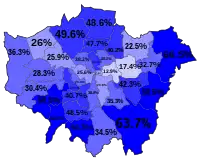 White: Total
White: Total White: British
White: British
Ethnicity of births
| Ethnic Group | Year[32] | |||||||||||
|---|---|---|---|---|---|---|---|---|---|---|---|---|
| 1981 estimates[33] | 2007 | 2010 | 2015 | 2019 | 2021[34] | |||||||
| Number | % | Number | % | Number | % | Number | % | Number | % | Number | % | |
| White: Total | – | 80% | 58,024 | 46.4% | 65,117 | 49.5% | 61,716 | 47.8% | 57,405 | 48.7% | 53,141 | 48% |
| White: British | – | – | – | – | – | – | – | – | – | – | 25,827 | 23.3% |
| White: Other | – | – | – | – | – | – | – | – | – | – | 27,314 | 24.7% |
| Asian / Asian British: Total | – | – | 21,701 | 17.3% | 24,445 | 18.5% | 26,957 | 20.9% | 24,616 | 20.9% | 24,426 | 22.1% |
| Asian / Asian British: Indian | – | – | – | – | – | – | – | – | – | – | 8,259 | 7.5% |
| Asian / Asian British: Pakistani | – | – | – | – | – | – | – | – | – | – | 4,341 | 3.9% |
| Asian / Asian British: Bangladeshi | – | – | – | – | – | – | – | – | – | – | 5,458 | 4.9% |
| Asian / Asian British: Other Asians | – | – | – | – | – | – | – | – | – | – | 6,368 | 5.8% |
| Black / Black British: Total | – | – | 22,036 | 17.6% | 22,293 | 16.9% | 18,526 | 14.3% | 15,319 | 13% | 13,476 | 12.2% |
| Black: Caribbean | – | – | – | – | – | – | – | – | – | – | 2,893 | 2.6% |
| Black: African | – | – | – | – | – | – | – | – | – | – | 8,697 | 7.9% |
| Black: Other Blacks | – | – | – | – | – | – | – | – | – | – | 1,886 | 1.7% |
| Mixed / British Mixed | – | – | 7,967 | 6.3% | 9,424 | 7.1% | 11,979 | 9.3% | 12,041 | 10.2% | 12,502 | 11.3% |
| Other: Total | – | – | 6,337 | 5% | 5,831 | 4.4% | 6,770 | 5.2% | 6,494 | 5.5% | 5,367 | 4.8% |
| Not Stated | – | – | 9,055 | 7.2% | 4,391 | 3.3% | 3,170 | 2.4% | 1,880 | 1.5% | 1,787 | 1.6% |
| Non-White: Total (not including Not stated) | – | 20% | 58,041 | 46.2% | 61,993 | 46.9% | 64,232 | 49.7% | 58,470 | 49.6% | 55,771 | 50.4% |
| Total: | – | 100% | 125,120 | 100% | 131,501 | 100% | 129,118 | 100% | 117,755 | 100% | 110,699 | 100% |
- Ethnicity of births as a percentage of total births in 2021
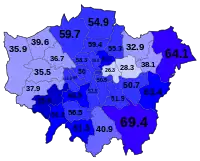 White (49.6% including Not stated)
White (49.6% including Not stated) White: British (24.9% including Not stated)
White: British (24.9% including Not stated) Asian (22.1%)
Asian (22.1%)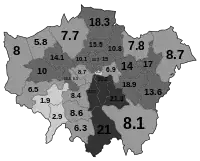 Black (12.2%)
Black (12.2%)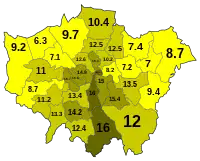 Mixed (11.3%)
Mixed (11.3%)
Ethnicity in boroughs
This table shows the proportion of different multi-ethnic groups by London borough, as found in the 2021 census.
| Broad multi-ethnic group make-up of London boroughs (2021) | |||||
|---|---|---|---|---|---|
| Local authority | White | Mixed | Asian | Black | Other |
| Barnet | 57.7 | 5.4 | 19.3 | 7.9 | 9.8 |
| Barking and Dagenham | 44.9 | 4.3 | 25.9 | 21.4 | 3.6 |
| Bexley | 71.9 | 3.5 | 9.9 | 12.2 | 2.5 |
| Brent | 34.6 | 5.1 | 32.8 | 17.5 | 10 |
| Bromley | 76.5 | 5.4 | 8.3 | 7.6 | 2.3 |
| Camden | 59.5 | 6.6 | 18.1 | 9.0 | 6.8 |
| City of London | 69.4 | 5.5 | 16.8 | 2.7 | 5.6 |
| Croydon | 48.4 | 7.6 | 17.5 | 22.6 | 3.9 |
| Ealing | 43.2 | 5.2 | 30.3 | 10.8 | 10.6 |
| Enfield | 52.1 | 5.9 | 11.5 | 18.3 | 12.1 |
| Greenwich | 55.7 | 6.0 | 13.2 | 21 | 4.2 |
| Hackney | 53.1 | 6.7 | 10.4 | 21.1 | 8.7 |
| Haringey | 57 | 7 | 8.7 | 17.6 | 9.7 |
| Harrow | 36.5 | 3.8 | 45.2 | 7.3 | 7.2 |
| Havering | 75.3 | 3.7 | 10.7 | 8.2 | 2 |
| Hammersmith and Fulham | 63.2 | 6.7 | 10.5 | 12.3 | 7.3 |
| Hillingdon | 48.2 | 4.4 | 33.3 | 7.8 | 6.3 |
| Hounslow | 44.1 | 4.7 | 36.7 | 7.2 | 7.3 |
| Islington | 62.2 | 7.5 | 9.9 | 13.3 | 7.1 |
| Kensington and Chelsea | 63.7 | 6.6 | 11.9 | 7.9 | 9.9 |
| Kingston upon Thames | 68.3 | 5.4 | 17.8 | 2.8 | 5.7 |
| Lambeth | 55 | 8.1 | 7.3 | 24 | 5.7 |
| Lewisham | 51.5 | 8.1 | 9 | 26.8 | 4.7 |
| Merton | 60.2 | 5.9 | 18.6 | 10.6 | 4.6 |
| Newham | 30.8 | 4.7 | 42.2 | 17.5 | 4.9 |
| Redbridge | 34.8 | 4.1 | 47.3 | 8.4 | 5.4 |
| Richmond upon Thames | 80.5 | 5.5 | 8.9 | 1.9 | 3.3 |
| Southwark | 51.4 | 7.2 | 9.9 | 25.1 | 6.3 |
| Sutton | 68.3 | 4.8 | 17.5 | 5.9 | 3.4 |
| Tower Hamlets | 39.4 | 5 | 44.4 | 7.3 | 3.9 |
| Waltham Forest | 52.8 | 6.5 | 19.9 | 15 | 5.8 |
| Wandsworth | 67.8 | 6.3 | 11.7 | 10.1 | 4.1 |
| Westminster | 55.2 | 6.5 | 16.8 | 8.1 | 13.5 |
- White multi-ethnic group over time
 1991 (79.8%)
1991 (79.8%)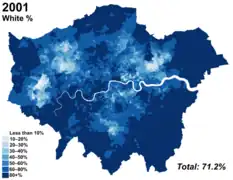 2001 (71.2%)
2001 (71.2%)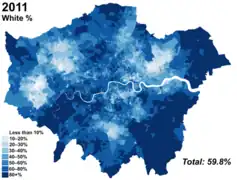 2011 (59.8%)
2011 (59.8%) 2021 (53.8%)
2021 (53.8%)
- Asian multi-ethnic group over time
 1991 (10.3%)
1991 (10.3%)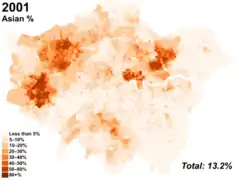 2001 (13.2%)
2001 (13.2%)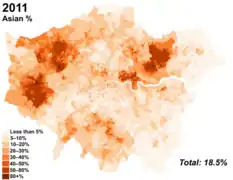 2011 (18.5%)
2011 (18.5%) 2021 (20.8%)
2021 (20.8%)
- Black multi-ethnic group over time
 1991 (8%)
1991 (8%)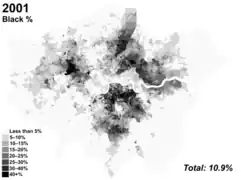 2001 (10.9%)
2001 (10.9%)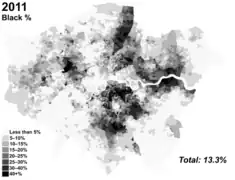 2011 (13.3%)
2011 (13.3%) 2021 (13.5%)
2021 (13.5%)
Country of birth




The 2021 census recorded that 3,575,740 people or 40.7% of London's population are foreign-born (including 27.9% born in a non-European country).[35]
| Country of Birth | Year | |||||||||||
|---|---|---|---|---|---|---|---|---|---|---|---|---|
| 1971[36][37] | 1981[38][39] | 1991[40] | 2001[41] | 2011[42] | 2021[35] | |||||||
| Number | % | Number | % | Number | % | Number | % | Number | % | Number | % | |
| Europe | 6,568,348 | 90.76% | 5,787,624 | 87.57% | 5,639,192 | 84.4% | 5,741,636 | 80% | 6,174,371 | 75.5% | 6,346,649 | 72.1% |
| 6,133,105 | 84.74% | 5,405,576 | 81.79% | 5,228,658 | 78.3% | 5,231,701 | 72.9% | 5,175,677 | 63.3% | 5,223,986 | 59.3% | |
| 236,396 | 3.26% | 199,460 | 3.01% | 214,033 | 157,556 | 129,807 | – | – | ||||
| European Community or Other Europe | 198,847 | 2.74% | 182,588 | 2.76% | 196,501 | 352,379 | 865,681 | 1,122,663 | 12.8% | |||
| Asia | 161,777 | 2.23% | 234,599 | 3.54% | 435,819 | 6.5% | 634,917 | 8.9% | 966,990 | 11.8% | 1,146,247 | 13% |
| 104,001 | 1.43% | 139,140 | 2.10% | 151,619 | – | – | 262,247 | – | – | |||
| 29,395 | 0.40% | 35,616 | 0.53% | 44,741 | – | – | 112,457 | – | – | |||
| – | – | 22,102 | 0.33% | 56,657 | – | – | 109,948 | – | – | |||
| Other Asia | 28,381 | 0.39% | 37,741 | 0.57% | – | – | – | – | – | – | – | – |
| Old Commonwealth | 38,738 | 0.53% | 37,064 | 0.56% | 53,320 | – | – | – | – | – | – | |
| Africa | 74,660 | 1.03% | 144,072 | 2.18% | 246,025 | 454,536 | 621,613 | 625,071 | 7.1% | |||
| America/Caribbean (also classed under New Commmonwealth) | 165,369 | 2.28% | 167,399 | 2.53% | 51,222 | 249,191 | 326,280 | 367,664 | 4.2% | |||
| Antarctica and Oceania (including Australasia) and Other | – | – | – | – | – | – | 70,632 | 84,661 | 64,228 | 0.7% | ||
| British Overseas | – | – | – | – | – | – | – | – | – | – | 5,994 | – |
| Other: Total | 227,829 | 3.14% | 237,840 | 3.59% | 1,119 | 21,179 | 26 | – | – | |||
| Total | 7,236,721 | 100.00% | 6,608,598 | 100.00% | 6,679,699 | 100% | 7,172,091 | 100% | 8,173,941 | 100% | 8,799,726 | 100% |
- Foreign born in the County of London (excluding Irish born in images)
 1901 (5% overall including Irish born)
1901 (5% overall including Irish born) 1911 (5% overall including Irish born)
1911 (5% overall including Irish born) 1921 (4% overall including Irish born)
1921 (4% overall including Irish born) 1931 (5% overall including Irish born)
1931 (5% overall including Irish born) 1951 (8% overall including Irish born)
1951 (8% overall including Irish born)
- Foreign born in London over time
 1961 (9.8%)
1961 (9.8%) 1971 (15.3%)
1971 (15.3%) 1981 (18.2%)
1981 (18.2%) 1991 (21.7%)
1991 (21.7%) 2001 (27.1%)
2001 (27.1%) 2011 (36.7%)
2011 (36.7%) 2021 (40.7%)
2021 (40.7%)
| Region of birth of mother[43] | 2001 | 2006 | 2011 | 2016 | 2021 | |||||
|---|---|---|---|---|---|---|---|---|---|---|
| Number | % | Number | % | Number | % | Number | % | Number | % | |
| United Kingdom | 59,104 | 56.7% | 57,376 | 47.5% | 57,450 | 43.2% | 53,866 | 41.8% | 47,958 | 43.2% |
| Foreign born | 45,058 | 43.3% | 63,522 | 52.5% | 75,383 | 56.7% | 74,923 | 58.2% | 62,986 | 56.8% |
| EU | 6,977 | 6.7% | 11,309 | 9.4% | 18,402 | 13.8% | 22,573 | 17.5% | 18,365 | 16.5% |
| Rest of Europe | 3,380 | 3.2% | 4,090 | 3.4% | 4,160 | 3.1% | 5,382 | 4.2% | 5,933 | 5.3% |
| Middle East and Asia | 13,489 | 13% | 18,206 | 15% | 25,478 | 19.2% | 24,235 | 18.8% | 21,394 | 19.2% |
| Africa | 13,600 | 13.1% | 20,043 | 16.6% | 19,866 | 15% | 15,600 | 12.1% | 10,725 | 9.7% |
| Rest of the world | 7,612 | 7.3% | 9,874 | 8.2% | 7,477 | 5.6% | 7,133 | 5.5% | 6,569 | 5.9% |
| Total | 104,162 | 100% | 120,898 | 100% | 132,843 | 100% | 128,803 | 100% | 110,961 | 100% |
- Born to foreign born mothers
 2007
2007 2014
2014 2021
2021
Age
- Population pyramids of country of birth groupings in 2021
 UK born
UK born Foreign born: Total
Foreign born: Total
Languages

According to the 2011 Census, 6,083,420 or 77.9% of London's population aged 3 and over spoke English as a main language, with a further 1,406,912 (19.8%) speaking it as a second language or well to very well.[44] 271,693 (3.5%) could not speak English well, while 47,917 (0.6%) could not speak English at all.[44] 2,456 (<0.1%) spoke other UK minority languages, with the most common being Welsh and 2,926 (<0.1%) used British Sign Language.[45] This shows also great challenges for TfL and other government services, for example most ticket vending machines use only English, French and up to 2 other western Europe hemisphere languages, while as shown below most demand is for Indian languages, Polish, etc.
The most common main languages spoken in Greater London according to the 2011 and 2021 censuses are shown below.[46]
Main language
| 2011 | 2021 | ||||
|---|---|---|---|---|---|
| Language | Number | Percentage | Number | Percentage | |
| English | 6,083,420 | 77.90% | 6,650,973 | 78.40% | |
| Polish | 147,816 | 1.90% | 112,068 | 1.30% | |
| Bengali | 114,267 | 1.50% | 101,975 | 1.20% | |
| Gujarati | 101,676 | 1.30% | 82,610 | 1.00% | |
| French | 84,191 | 1.10% | 67,049 | 0.80% | |
| Urdu | 78,667 | 1.00% | 63,626 | 0.80% | |
| Portuguese | 71,525 | 0.90% | 94,205 | 1.10% | |
| Turkish | 71,242 | 0.90% | 69,641 | 0.80% | |
| Spanish | 71,192 | 0.90% | 117,457 | 1.40% | |
| Arabic | 70,602 | 0.90% | 72,102 | 0.80% | |
| Tamil | 70,565 | 0.90% | 70,673 | 0.80% | |
| Punjabi | 68,525 | 0.90% | 74,205 | 0.90% | |
| Somali | 54,852 | 0.70% | 37,346 | 0.40% | |
| Italian | 49,484 | 0.60% | 81,293 | 1.00% | |
| Romanian | 39,653 | 0.50% | 159,338 | 1.90% | |
| Persian | 39,645 | 0.50% | 39,233 | 0.50% | |
| Lithuanian | 35,341 | 0.50% | 30,768 | 0.40% | |
| German | 31,306 | 0.40% | 19,074 | 0.20% | |
| Greek | 26,924 | 0.30% | 36,015 | 0.40% | |
| Russian | 26,603 | 0.30% | 31,906 | 0.40% | |
| Other | 441,968 | 5.66% | |||
Proficiency in English
| Language proficiency | London (aged 3 and over) | |||
|---|---|---|---|---|
| 2011[47] | 2021[48] | |||
| Number | % | Number | % | |
| Main language is English | 6,083,420 | 77.9% | 6,650,973 | 78.4% |
| Main language is not English | 1,726,522 | 22.1% | 1,831,690 | 21.6% |
| Can speak English very well | 763,502 | 9.8% | 840,463 | 9.9% |
| Can speak English well | 643,410 | 8.2% | 636,226 | 7.5% |
| Cannot speak English well | 271,693 | 3.5% | 303,265 | 3.6% |
| Cannot speak English | 47,917 | 0.6% | 51,736 | 0.6% |
| Total | 7,809,942 | 100% | 8,482,663 | 100% |
Religion

London's religious landscape over the past two decades has undergone significant change. In 2001, Christians constituted the majority at 58.23%, but by 2021, this percentage had declined to 40.66%. Meanwhile, the population identifying with no religion saw a significant increase, rising from 15.76% in 2001 to 27.05% in 2021. This shift suggests a growing trend of secularization in the city.
The Muslim population also experienced notable growth, increasing from 8.46% in 2001 to 14.99% in 2021. The number of individuals who chose not to state their religion slightly fluctuated during these years, from 8.66% in 2001 to 7.00% in 2021.
Hinduism saw steady growth, constituting 4.07% of the population in 2001 and rising to 5.15% in 2021. The Jewish community remained relatively stable but saw a slight decline from 2.09% to 1.65% over the same period. Sikhism also experienced growth, albeit modest, from 1.45% in 2001 to 1.64% in 2021. Other religions, including Buddhism, collectively accounted for small but fluctuating percentages, with Buddhism specifically ranging from 0.76% in 2001 to 0.88% in 2021.
These changes are influenced by various factors, including immigration, generational attitudes, and broader social trends.
| Religion | 2001[49] | 2011[50] | 2021[51] | |||
|---|---|---|---|---|---|---|
| Number | % | Number | % | Number | % | |
| Christian | 4,176,175 | 58.23% | 3,957,984 | 48.42% | 3,577,681 | 40.66% |
| No religion | 1,130,616 | 15.76% | 1,694,372 | 20.73% | 2,380,404 | 27.05% |
| Muslim | 607,083 | 8.46% | 1,012,823 | 12.39% | 1,318,754 | 14.99% |
| Religion not stated | 621,366 | 8.66% | 692,739 | 8.47% | 615,662 | 7.00% |
| Hindu | 291,977 | 4.07% | 411,291 | 5.03% | 453,034 | 5.15% |
| Jewish | 149,789 | 2.09% | 148,602 | 1.82% | 145,466 | 1.65% |
| Sikh | 104,230 | 1.45% | 126,134 | 1.54% | 144,543 | 1.64% |
| Other religion | 36,558 | 0.51% | 47,970 | 0.59% | 86,759 | 0.99% |
| Buddhist | 54,297 | 0.76% | 82,026 | 1.00% | 77,425 | 0.88% |
| Total | 7,172,091 | 100.00% | 8,173,941 | 100.00% | 8,799,728 | 100.00% |
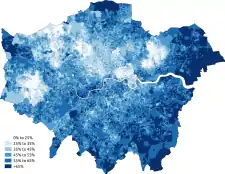 Christianity
Christianity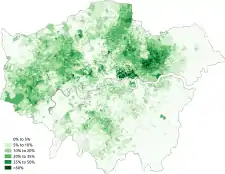 Islam
Islam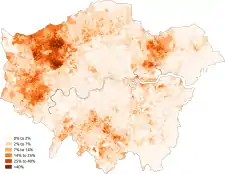 Hinduism
Hinduism Judaism
Judaism Sikhism
Sikhism Buddhism
Buddhism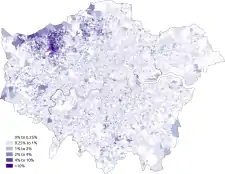 Other religion
Other religion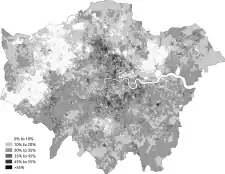 No religion
No religion

- Population pyramids of each religious group in London
 Christian
Christian No religion
No religion None stated
None stated Muslim
Muslim Hindu
Hindu Buddhist
Buddhist Sikh
Sikh Jewish
Jewish Other religion
Other religion
Social issues
Marriage and divorce
In 2019, a total of 29,139 marriages occurred within London.[52]
Abortion
In 2020, 27.7% of conceptions were aborted in the city.[53]
- Abortion in London
 Percentage of conceptions aborted in London by each borough in 2020
Percentage of conceptions aborted in London by each borough in 2020 Abortion rates by age group in London
Abortion rates by age group in London
Sexual orientation and gender identity
| Sexual orientation | London (aged 16 and over) | |
|---|---|---|
| 2021[54] | ||
| Number | % | |
| Straight or Heterosexual | 6,123,195 | 86.2% |
| Gay or Lesbian | 158,760 | 2.2% |
| Bisexual | 108,140 | 1.5% |
| All other sexual orientations | 37,482 | 0.5% |
| Not answered | 676,408 | 9.5% |
| Total | 7,103,985 | 100% |
| Gender identity | London (aged 16 and over) | |
|---|---|---|
| 2021[55] | ||
| Number | % | |
| Gender identity the same as sex registered at birth | 6,479,664 | 91.2 |
| Gender identity different from sex registered at birth but no specific identity given | 32,753 | 0.5% |
| Trans woman | 11,266 | 0.2% |
| Trans man | 11,480 | 0.2% |
| All other gender identities | 8,862 | 0.1% |
| Not answered | 559,960 | 7.9% |
| Total | 7,103,985 | 100% |
Health
In 2021, the suicide rate in total was 6.6 for every 100,000 people.[56] For males this was 9.9 and for females this was 3.4.[56]
- Variety of health issues in graphs
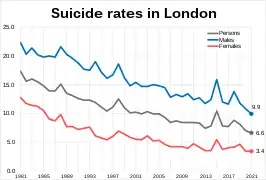 Suicide rates in London
Suicide rates in London Drug misuse rate in London
Drug misuse rate in London Percentage of Year 6s obese in 2020 in London
Percentage of Year 6s obese in 2020 in London Percentage of Reception age children obese in 2020
Percentage of Reception age children obese in 2020
General health
| General health (self-identified) | 2001[57] | 2011[58] | 2021[59] | |||
|---|---|---|---|---|---|---|
| Number | % | Number | % | Number | % | |
| Very good health | 5,078,978 | 70.8% | 4,127,788 | 50.5% | 4,712,358 | 53.6% |
| Good health | 2,725,645 | 33.3% | 2,802,395 | 31.8% | ||
| Fair health | 1,499,198 | 20.9% | 915,035 | 11.2% | 908,941 | 10.3% |
| Bad health | 593,915 | 8.3% | 305,343 | 3.7% | 283,864 | 3.2% |
| Very bad health | 100,130 | 1.2% | 92,170 | 1.0% | ||
| Total | 7,172,091 | 100% | 8,173,941 | 100% | 8,799,728 | 100% |
Disability
| Disability status | London | |||||||
|---|---|---|---|---|---|---|---|---|
| 1991 (long term illness)[60] | 2001 (limiting long term illness)[61] | 2011[62] | 2021[63] | |||||
| Number | % | Number | % | Number | % | Number | % | |
| Disabled (under the Equality Act) | 742,870 | 10.7% | 1,111,284 | 15.5% | 1,157,16 | 14.1% | 1,164,456 | 13.2% |
| Disabled under the Equality Act: Day-to-day activities limited a little | – | – | – | – | 605,501 | 7.4% | 658,547 | 7.5% |
| Disabled under the Equality Act: Day-to-day activities limited a lot | – | – | – | – | 551,664 | 6.7% | 505,909 | 5.7% |
| Not disabled (under the Equality Act) | – | – | – | – | 7,016,776 | 85.8% | 7,635,272 | 86.8% |
| Not disabled under the Equality Act: No long term physical or mental health conditions | – | – | – | – | 7,016,776 | 85.8% | 7,175,718 | 81.5% |
| Not disabled under the Equality Act: Has long term physical or mental health condition but day-to-day activities are not limited | – | – | – | – | – | – | 459,554 | 5.2% |
| Total | 6,887,280 | 100% | 7,172,091 | 100% | 8,173,941 | 100% | 8,799,728 | 100% |
Income and industry
The vast majority of people within London work in the service sector.[64]
- Income and industry of London in images
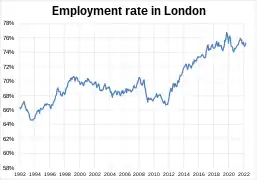 Employment rate in London
Employment rate in London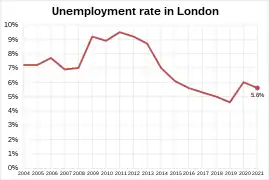 Unemployment rate in London
Unemployment rate in London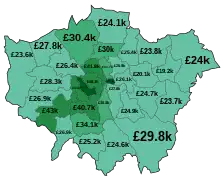 Gross Domestic Household Income (GDHI) across London in 2020
Gross Domestic Household Income (GDHI) across London in 2020 Employment in public or private sector in London
Employment in public or private sector in London
Industry

| Industry sector | London (aged 16 and over in employment) | |||||||||||
|---|---|---|---|---|---|---|---|---|---|---|---|---|
| 1961 (10% sample)[65] | 1981 (10% sample)[66] | 1991 (10% sample)[67] | 2001[68] | 2011[69] | 2021[70] | |||||||
| Number | % | Number | % | Number | % | Number | % | Number | % | Number | % | |
| A: Agriculture, Forestry and fishing | 772 | 0.2% | 445 | – | 613 | – | 11,033 | 0.3% | 2,363 | 0.1% | 2,827 | 0.1% |
| B: Mining and quarrying | 296 | – | – | – | 2,961 | 1% | 4,487 | 0.1% | 5,606 | 0.1% | 4,957 | 0.1% |
| C: Manufacturing | 156,035 (Production) | 41.5% | 58,649 | 19.1% | 29,889 | 10.5% | 253,358 | 7.6% | 128,905 | 3.2% | 131,674 | 3.0% |
| D: Electricity, gas, steam and air conditioning supply | 5,181 | 1.7% | 3,195 | 1.1% | 11,035 | 0.3% | 10,358 | 0.3% | 15,040 | 0.3% | ||
| E: Water supply; Sewerage, Waste management and Remediation activities | 14,207 | 0.4% | 12,732 | 0.3% | ||||||||
| F: Construction | 20,347 | 6.6% | 18,395 | 6.5% | 174,731 | 5.3% | 262,356 | 6.6% | 340,992 | 7.8% | ||
| G: Wholesale and retail trade; repair of motor vehicles and motorcycles | – | – | – | – | – | – | 478,374 | 14.4% | 522,204 | 13.1% | 531,842 | 12.2% |
| H: Transport and storage | – | – | 29,760 | 9.7% | 25,056 | 8.9% | 270,358 | 8.1% | 200,336 | 205,733 | 4.7% | |
| J: Information and communication | – | – | – | – | – | – | 276,355 | 6.9% | 332,394 | 7.6% | ||
| I: Accommodation and food service activities (Distribution or catering; 1981 + 1991) | 213,766 (Services) | 56.9% | 58,778 | 19.2% | 54,123 | 19.1% | 153,357 | 4.6% | 251,574 | 237,887 | 5.5% | |
| K: Financial and insurance activities | – | – | 57,672 | 20.4% | 937,377 | 28.3% | 306,443 | 288,113 | 6.6% | |||
| L: Real estate activities | – | – | 79,520 | 92,403 | 2.1% | |||||||
| M: Professional, scientific and technical activities | – | – | 434,405 | 456,965 | 10.5% | |||||||
| N: Administrative and support service activities | – | – | 234,191 | 262,952 | 6.0% | |||||||
| P: Education | – | – | – | – | 247,767 | 7.5% | 384,156 | 418,765 | 9.6% | |||
| Q: Human health and social work activities | – | – | – | – | 334,783 | 10.1% | 428,586 | 563,238 | 12.9% | |||
| O: Public administration and defence; compulsory social security | 4,795 | 1.3% | – | – | – | – | 178,261 | 5.4% | 201,545 | 209,607 | 4.8% | |
| R, S, T, U: Other and not stated | – | – | 131,194 | 42.6% | 90,740 | 32.1% | 264,213 | 8.0% | 255,787 | 251,958 | 5.8% | |
| Total | 375,664 | 100% | 307,857 | 100% | 282,644 | 100% | 3,319,134 | 100% | 3,998,897 | 100% | 4,360,079 | 100% |
Method of transportation to work
| Method of transportation | London (aged 16 and over in employment) | |||||||||
|---|---|---|---|---|---|---|---|---|---|---|
| 1981 (10% sample)[71] | 1991 (10% sample)[72] | 2001[73] | 2011[74] | 2021[75] | ||||||
| Number | % | Number | % | Number | % | Number | % | Number | % | |
| Work mainly at or from home | 9,593 | 3.1% | 12,433 | 4.4% | 285,935 | 7.5% | 202,679 | 5.1% | 1,836,823 | 42.1% |
| Underground, metro, light rail, tram | 39,035 | 12.7% | – | – | 642,476 | 16.9% | 902,263 | 22.6% | 431,842 | 9.9% |
| Train | 32,638 | 10.6% | 74,262 | 26.3% | 661,166 | 17.4% | 532,720 | 13.3% | 231,074 | 5.3% |
| Bus, minibus or coach | 51,409 | 16.7% | 32,131 | 11.4% | 376,926 | 9.9% | 561,605 | 14.0% | 386,068 | 8.9% |
| Taxi | – | – | – | – | 21,962 | 0.6% | 20,314 | 0.5% | 22,544 | 0.5% |
| Motorcycle, scooter or moped | 6,481 | 2.1% | 3,239 | 1.1% | 55,752 | 1.5% | 45,976 | 1.1% | 30,404 | 0.7% |
| Driving a car or van | 90,522 | 29.4% | 108,546 | 38.4% | 1,294,081 | 34.0% | 1,120,826 | 28.0% | 897,111 | 20.6% |
| Passenger in a car or van | 22,903 | 7.4% | 10,068 | 3.6% | 92,819 | 2.4% | 69,659 | 1.7% | 63,883 | 1.5% |
| Bicycle | 7,308 | 2.4% | 5,783 | 2.0% | 78,804 | 2.1% | 161,705 | 4.0% | 128,833 | 3.0% |
| On foot | 40,563 | 13.2% | 27,523 | 9.7% | 281,338 | 7.4% | 352,612 | 8.8% | 279,453 | 6.4% |
| Other method of travel to work (or Not stated) | 7,405 | 2.4% | 8,659 | 3.1% | 14,396 | 0.4% | 28,538 | 0.7% | 52,040 | 1.2% |
| Total | 307,857 | 100% | 282,644 | 100% | 3,805,655 | 100% | 3,998,897 | 100% | 4,360,075 | 100% |
Hours worked weekly
| Hours worked weekly | London (aged 16 and over in employment) | |||||||
|---|---|---|---|---|---|---|---|---|
| 1991 (10% sample)[76] | 2001[77] | 2011[78] | 2021[79] | |||||
| Number | % | Number | % | Number | % | Number | % | |
| Full-time | 224,494 | 79.4% | 2,651,793 | 79.9% | 2,973,844 | 74.4% | 3,137,424 | 72% |
| Full-time: 31 to 48 hours worked | 224,494 | 79.4% | 2,063,598 | 62.2% | 2,338,716 | 58.4% | 2,555,494 | 58.6% |
| Full-time: 49 or more hours worked | 588,195 | 17.7% | 635,128 | 15.9% | 581,930 | 13.3% | ||
| Part-time | 46,319 | 16.4% | 667,341 | 20.1% | 1,025,053 | 25.6% | 1,222,653 | 28% |
| Part-time: 15 hours or less worked | 15,812 | 5.6% | 224,349 | 6.8% | 346,106 | 8.7% | 464,497 | 10.7% |
| Part-time: 16 to 30 hours worked | 30,507 | 10.8% | 442,992 | 13.3% | 678,947 | 17% | 758,156 | 17.3% |
| Not stated | 11,831 | 4.1% | – | – | – | – | – | – |
| Total | 282,644 | 100% | 3,319,134 | 100% | 3,998,897 | 100% | 4,360,077 | 100% |
Distance to travel to work
| Distance to travel to work | 2001[80] | 2011[81] | 2021[82] | |||
|---|---|---|---|---|---|---|
| Number | % | Number | % | Number | % | |
| Less than 2km | 475,102 | 14.3% | 474,585 | 11.9% | 331,191 | 7.6% |
| 2km to less than 5km | 659,230 | 19.9% | 715,936 | 17.9% | 484,894 | 11.1% |
| 5km to less than 10km | 803,143 | 24.2% | 926,646 | 23.2% | 533,671 | 12.2% |
| 10km to less than 20km | 686,960 | 20.7% | 795,833 | 19.9% | 409,530 | 9.4% |
| 20km to less than 30km | 128,560 | 3.9% | 154,589 | 3.9% | 79,897 | 1.8% |
| 30km to less than 40km | 32,812 | 1.0% | 38,310 | 1.0% | 23,145 | 0.5% |
| 40km to less than 60km | 25,001 | 0.8% | 28,294 | 0.7% | 15,808 | 0.4% |
| 60km and over | 36,282 | 1.1% | 52,083 | 1.3% | 29,917 | 0.7% |
| Works mainly from home | 285,935 | 8.6% | 380,665 | 9.5% | 1,836,823 | 42.1% |
| Works mainly at an offshore installation, in no fixed place, or outside the UK | 186,109 | 5.6% | – | – | 615,201 | 14.1% |
| Other | – | – | 431,956 | 10.8% | – | – |
| Total | 3,319,134 | 100% | 3,998,897 | 100% | 4,360,077 | 100% |
National identity

| National identity | 2011[83] | 2021[84] | ||
|---|---|---|---|---|
| Number | % | Number | % | |
| British only | 2,526,808 | 30.9% | 5,011,396 | 56.9% |
| English only | 3,035,090 | 37.1% | 717,894 | 8.2% |
| Welsh only | 31,952 | 0.4% | 19,167 | 0.2% |
| Scottish only | 53,531 | 0.7% | 29,943 | 0.3% |
| Northern Irish only | 19,943 | 0.2% | 13,917 | 0.2% |
| Any combination of UK only identities | – | – | 14,484 | 0.2% |
| English and British only | 444,115 | 5.4% | 594,149 | 6.8% |
| Welsh and British only | 7,081 | 0.1% | 10,161 | 0.1% |
| Scottish and British only | 11,344 | 0.1% | 15,665 | 0.2% |
| Northern Irish and British only | 2,530 | 0.0% | 4,504 | 0.1% |
| Irish only | 125,733 | 1.5% | 99,780 | 1.1% |
| Irish and at least one UK identity | 7,169 | 0.1% | 16,941 | 0.2% |
| Other identity only | 1,830,912 | 22.4% | 1,878,830 | 21.4% |
| Other identity and at least one UK identity | 191,771 | 2.3% | 372,898 | 4.2% |
| Total | 8,173,941 | 100% | 8,799,729 | 100% |
Note: The order of options for the census question on national identity was changed between 2011 and 2021. In 2011 "English only" was the first group listed whereas in 2021 "British only" was first instead.[85]
- Population pyramids of identity groupings in 2021
 English only identity
English only identity English and British identity
English and British identity British only identity
British only identity UK and non-UK identity
UK and non-UK identity Non-UK only identity
Non-UK only identity
Education
Level of qualification
| Level of qualification | London (aged 16 and over, not in education) | |||||
|---|---|---|---|---|---|---|
| 2001[86] | 2011[87] | 2021[88] | ||||
| Number | % | Number | % | Number | % | |
| No qualifications | 1,257,929 | 23.7% | 1,152,517 | 17.6% | 1,151,250 | 16.2% |
| Level 1 and entry level qualifications | 689,228 | 13.0% | 702,687 | 10.7% | 545,269 | 7.7% |
| Level 2 qualifications | 904,205 | 17.1% | 775,928 | 11.8% | 707,518 | 10.0% |
| Apprenticeship | – | – | 107,665 | 1.6% | 227,622 | 3.2% |
| Level 3 qualifications | 518,624 | 9.8% | 685,508 | 10.5% | 937,875 | 13.2% |
| Level 4 qualifications or above | 1,642,467 | 31.0% | 2,470,225 | 37.7% | 3,316,829 | 46.7% |
| Other qualifications | 287,879 | 5.4% | 654,643 | 10.0% | 217,622 | 3.1% |
| Total | 5,300,332 | 100% | 6,549,173 | 100% | 7,103,985 | 100% |
See also
- Demography of the United Kingdom
- Demography of England
- Demography of Birmingham
- Demography of Greater Manchester
- Religion in London
- Religion in England
- List of English cities by population
- List of English districts by population
- List of English districts and their ethnic composition
- List of English districts by area
- List of English districts by population density
References
- "Land Area and Population Density, Ward and Borough – London Datastore". Retrieved 13 December 2022.
- "Population and household estimates, England and Wales - Office for National Statistics". www.ons.gov.uk. Retrieved 13 December 2022.
- "Life expectancy for local areas of the UK - Office for National Statistics". www.ons.gov.uk. Retrieved 13 December 2022.
- "Births and Fertility Rates, Borough – London Datastore". Retrieved 10 December 2022.
- "Infant mortality". Trust for London. Retrieved 13 December 2022.
- "Population and household estimates, England and Wales: Census 2021 - Office for National Statistics". www.ons.gov.uk. Retrieved 18 July 2022.
- "A Beginners Guide to UK Geography (2021) v1.0". geoportal.statistics.gov.uk. p. 12. Retrieved 15 May 2023.
- "Why have the white British left London?". BBC News. 20 February 2013. Retrieved 12 December 2022.
- Estimates of the population for the UK, England and Wales, Scotland and Northern Ireland
- "London through time: Population Statistics: Total Population". A vision of Britain through time. Great Britain Historical GIS. Retrieved 19 November 2009.
- "Outer London through time: Population Statistics: Total Population". A vision of Britain through time. Great Britain Historical GIS. Retrieved 19 November 2009.
- "Inner London through time: Population Statistics: Total Population". A vision of Britain through time. Great Britain Historical GIS. Retrieved 19 November 2009.
- "Archived copy" (PDF). Archived from the original (PDF) on 21 October 2014. Retrieved 6 June 2014.
{{cite web}}: CS1 maint: archived copy as title (link) - "Births in England and Wales: summary tables - Office for National Statistics". www.ons.gov.uk. Retrieved 11 December 2022.
- "Demography, London's Population & Geography - Trust For London". Trust for London. Retrieved 10 December 2022.
- "KS01 Usual resident population: Census 2001, Key Statistics for urban areas". Office for National Statistics. Archived from the original on 11 March 2005.
- Mayor of London. "The London Plan". Greater London Authority.
- "British urban pattern: population data" (PDF). ESPON project 1.4.3 Study on Urban Functions. European Spatial Planning Observation Network. March 2007. p. 119. Archived from the original (pdf) on 24 September 2015. Retrieved 22 February 2010.
- Goodhew, David; Cooper, Anthony-Paul (2018), "The Desecularisation of the City: London's Churches, 1980 to the Present", The Desecularisation of the City, pp. 3–38, doi:10.4324/9781351167765-1, ISBN 9781351167765, S2CID 240171114, retrieved 4 December 2022
- Benedictus, Leo (25 January 2005). "Every race, colour, nation and religion on earth". The Guardian. Retrieved 22 August 2009.
- Lee, Trevor R. (30 June 2010). "Immigrants in London: Trends in distribution and concentration 1961–71". Journal of Ethnic and Migration Studies. 2 (2): 145–158. doi:10.1080/1369183x.1973.9975191. ISSN 1369-183X.
- Collins, Charles (1971). "Distribution of Commonwealth immigrants in Greater London". Ekistics. 32 (188): 12–21. ISSN 0013-2942.
- Jones, P. N. (1978). "The Distribution and Diffusion of the Coloured Population in England and Wales, 1961-71". Transactions of the Institute of British Geographers. 3 (4): 515–532. doi:10.2307/622127. ISSN 0020-2754. JSTOR 622127. PMID 12157820.
- Equality, Commission for Racial (1985). "Ethnic minorities in Britain: statistical information on the pattern of settlement". Commission for Racial Equality: Table 2.2.
- Peach, Ceri (1 July 1986). "A geographical perspective on the 1981 urban riots in England". Ethnic and Racial Studies. 9 (3): 396–411. doi:10.1080/01419870.1986.9993541. ISSN 0141-9870.
- "1991 census - local base statistics - Nomis - Official Census and Labour Market Statistics". www.nomisweb.co.uk. Retrieved 18 June 2023.
- "Office of National Statistics; 2001 Census Key Statistics". webarchive.nationalarchives.gov.uk. Retrieved 7 September 2021.
- "2011 Census: Ethnic Group, local authorities in England and Wales". webarchive.nationalarchives.gov.uk. Retrieved 15 December 2021.
- "Ethnic group - Office for National Statistics". www.ons.gov.uk. Retrieved 29 November 2022.
- "School and pupil characteristics". webarchive.nationalarchives.gov.uk. Retrieved 8 November 2022.
- "Schools, pupils and their characteristics, Academic Year 2021/22". explore-education-statistics.service.gov.uk. Retrieved 9 September 2022.
- "Births and infant mortality by ethnicity, England and Wales". Retrieved 31 January 2022.
- Coleman, David (1 January 1983). "Some problems of data for the demographic study of immigration and of immigrant and minority populations in Britain". Ethnic and Racial Studies. 6 (1): 103–110. doi:10.1080/01419870.1983.9993401. ISSN 0141-9870.
- "Live births by ethnicity and local authority, 2020 to 2021 - Office for National Statistics". www.ons.gov.uk. Retrieved 10 May 2023.
- "Demography and migration data, England and Wales - Office for National Statistics". www.ons.gov.uk. Retrieved 3 November 2022.
- As UK Census data past 2001 is unavailable through the ONS website, it has been recommended to use archival census collection websites to obtain data. Taken from Casweb UK Data Service from the 1971 UK wide Census. SAS08 of Country of Birth of England > Greater London.
- Registrar General for England and Wales ; General Register Office Scotland (2002): 1971 Census aggregate data. UK Data Service. DOI: http://dx.doi.org/10.5257/census/aggregate-1971-1 This information is licensed under the terms of the Open Government Licence
- As UK Census data past 2001 is unavailable through the ONS website, it has been recommended to use archival census collection websites to obtain data. Taken from Casweb UK Data Service from the 1981 UK wide Census. Table 4 of Country of Birth in England > Inner and Outer London.
- Office of Population Censuses and Surveys ; Registrar General for Scotland (2000): 1981 Census aggregate data (Edition: 2000). UK Data Service. DOI: http://dx.doi.org/10.5257/census/aggregate-1981-1 This information is licensed under the terms of the Open Government Licence
- Data taken from 1991 census data query on NOMIS
- "Table Finder - 2001 Census - Nomis - Official Census and Labour Market Statistics". www.nomisweb.co.uk. Retrieved 4 November 2022.
- "Table Finder - 2011 Census - Nomis - Official Census and Labour Market Statistics". www.nomisweb.co.uk. Retrieved 4 November 2022.
- "Parents' country of birth - Office for National Statistics". www.ons.gov.uk. Retrieved 8 May 2023.
- "Proficiency in English, 2011 (QS205EW)". Office for National Statistics. Retrieved 17 April 2013.
- "Main Language (detailed), 2011 (QS204EW)". Office for National Statistics. Retrieved 17 April 2013.
- "Download:local authorities: county / unitary". NOMIS. Retrieved 5 September 2014.
- "QS205EW (Proficiency in English) - Nomis - Official Census and Labour Market Statistics". www.nomisweb.co.uk. Retrieved 7 May 2023.
- "TS029 - Proficiency in English - Nomis - Official Census and Labour Market Statistics". www.nomisweb.co.uk. Retrieved 7 May 2023.
- "2001 census – theme tables". Retrieved 5 September 2014.
- "Religion by measures". NOMIS. Retrieved 2 September 2014.
- "Religion". Office for National Statistics. Retrieved 30 November 2022.
- "Marriages in England and Wales - Office for National Statistics". www.ons.gov.uk. Retrieved 11 December 2022.
- "Conceptions in England and Wales - Office for National Statistics". www.ons.gov.uk. Retrieved 11 December 2022.
- "TS077 - Sexual orientation - Nomis - Official Census and Labour Market Statistics". www.nomisweb.co.uk. Retrieved 7 May 2023.
- "TS078 - Gender identity - Nomis - Official Census and Labour Market Statistics". www.nomisweb.co.uk. Retrieved 7 May 2023.
- "Suicides in England and Wales - Office for National Statistics". www.ons.gov.uk. Retrieved 11 December 2022.
- "KS008 - Health and provision of unpaid care - Nomis - Official Census and Labour Market Statistics". www.nomisweb.co.uk. Retrieved 7 May 2023.
- "QS302EW (General health) - Nomis - Official Census and Labour Market Statistics". www.nomisweb.co.uk. Retrieved 7 May 2023.
- "TS037 - General health - Nomis - Official Census and Labour Market Statistics". www.nomisweb.co.uk. Retrieved 7 May 2023.
- "1991 census - local base statistics - Nomis - Official Census and Labour Market Statistics". www.nomisweb.co.uk. Retrieved 8 May 2023.
- "KS008 - Health and provision of unpaid care - Nomis - Official Census and Labour Market Statistics". www.nomisweb.co.uk. Retrieved 8 May 2023.
- "QS303EW (Long-term health problem or disability) - Nomis - Official Census and Labour Market Statistics". www.nomisweb.co.uk. Retrieved 8 May 2023.
- "TS038 - Disability - Nomis - Official Census and Labour Market Statistics". www.nomisweb.co.uk. Retrieved 8 May 2023.
- "Five facts about... The UK service sector - Office for National Statistics". www.ons.gov.uk. Retrieved 30 September 2022.
- "ST05 (Industry (10% Sample) [1961 census]) - Nomis - Official Census and Labour Market Statistics". www.nomisweb.co.uk. Retrieved 8 May 2023.
- "1981 census - small area statistics - Nomis - Official Census and Labour Market Statistics". www.nomisweb.co.uk. Retrieved 8 May 2023.
- "1991 census - local base statistics - Nomis - Official Census and Labour Market Statistics". www.nomisweb.co.uk. Retrieved 8 May 2023.
- "KS011a - Industry of employment - Nomis - Official Census and Labour Market Statistics". www.nomisweb.co.uk. Retrieved 8 May 2023.
- "QS605EW (Industry) - Nomis - Official Census and Labour Market Statistics". www.nomisweb.co.uk. Retrieved 8 May 2023.
- "TS060 - Industry - Nomis - Official Census and Labour Market Statistics". www.nomisweb.co.uk. Retrieved 8 May 2023.
- "1981 census - small area statistics - Nomis - Official Census and Labour Market Statistics". www.nomisweb.co.uk. Retrieved 7 May 2023.
- "1991 census - local base statistics - Nomis - Official Census and Labour Market Statistics". www.nomisweb.co.uk. Retrieved 7 May 2023.
- "UV037 - Method of travel to work - Nomis - Official Census and Labour Market Statistics". www.nomisweb.co.uk. Retrieved 7 May 2023.
- "QS701EW (Method of travel to work) - Nomis - Official Census and Labour Market Statistics". www.nomisweb.co.uk. Retrieved 7 May 2023.
- "TS061 - Method used to travel to work - Nomis - Official Census and Labour Market Statistics". www.nomisweb.co.uk. Retrieved 7 May 2023.
- "1991 census - local base statistics - Nomis - Official Census and Labour Market Statistics". www.nomisweb.co.uk. Retrieved 8 May 2023.
- "UV041 - Hours Worked - Nomis - Official Census and Labour Market Statistics". www.nomisweb.co.uk. Retrieved 8 May 2023.
- "QS604EW (Hours worked) - Nomis - Official Census and Labour Market Statistics". www.nomisweb.co.uk. Retrieved 8 May 2023.
- "TS059 - Hours worked - Nomis - Official Census and Labour Market Statistics". www.nomisweb.co.uk. Retrieved 8 May 2023.
- "UV035 - Distance travelled to work - Nomis - Official Census and Labour Market Statistics". www.nomisweb.co.uk. Retrieved 8 May 2023.
- "QS702EW (Distance travelled to work) - Nomis - Official Census and Labour Market Statistics". www.nomisweb.co.uk. Retrieved 8 May 2023.
- "TS058 - Distance travelled to work - Nomis - Official Census and Labour Market Statistics". www.nomisweb.co.uk. Retrieved 8 May 2023.
- "KS202EW (National identity) - Nomis - Official Census and Labour Market Statistics". www.nomisweb.co.uk. Retrieved 8 May 2023.
- "TS027 - National identity - UK - Nomis - Official Census and Labour Market Statistics". www.nomisweb.co.uk. Retrieved 8 May 2023.
- "Ethnic group, national identity, language, and religion quality information for Census 2021". Office for National Statistics. Retrieved 31 May 2023.
- "KS013 - Qualifications and students - Nomis - Official Census and Labour Market Statistics". www.nomisweb.co.uk. Retrieved 7 May 2023.
- "KS501UK - Qualifications and students". NOMIS.
- "TS067 - Highest level of qualification - Nomis - Official Census and Labour Market Statistics". www.nomisweb.co.uk. Retrieved 7 May 2023.